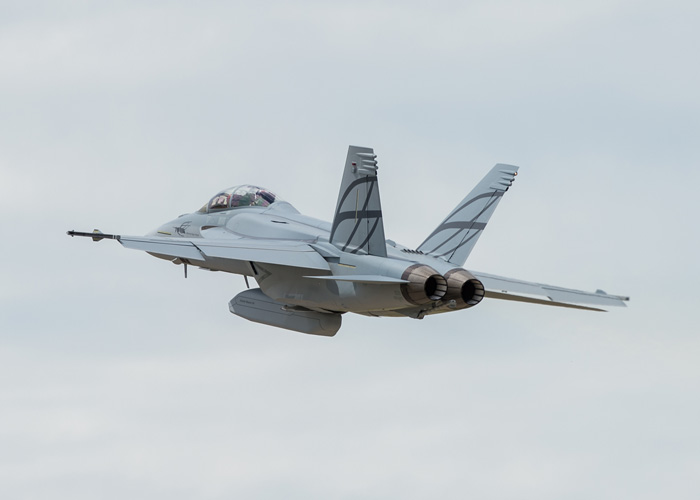






Plissken_101_AB escribió:http://news.usni.org/2013/08/27/document-boeings-advanced-super-hornet


ST. LOUIS — With more than 600 copies of the F/A-18 Super Hornet strike fighter in service, more still being built and the export market only starting to be tapped, Boeing has been eyeing ways to modify and upgrade the aircraft to keep it viable in an ever-changing threat environment.
The key is to reduce radar and heat signatures, improve fuel carrying capacity, upgrade avionics, cockpit and engine systems, and do it all at a price that won’t overwhelm potential customers.The result is the Advanced Super Hornet (ASH). Not a single aircraft, it is instead a package of options that can be bought singly or all together, made to order for new aircraft or retrofitted on existing planes.
“We want to give the customer options,” Paul Summers, Boeing’s director for Super Hornet and Growler programs, told a group of reporters brought last month, at company expense, to the Boeing factory in St. Louis, where all variants of the aircraft are built.From its beginnings in late 2009 as the Super Hornet International Roadmap, the concept has evolved into a package of enhancements aimed not just at export customers, but at the US Navy, by far the largest operator of the plane.
“It fits the domestic market better right now,” said Mark Gammon, Boeing’s program manager for Super Hornet and Growler advanced capabilities. The modifications are adaptable to all three Super Hornet variants: the one-seat F/A-18E and two-seat F/A-18F Super Hornet strike fighters, and the two-seat E/A-18G Growler electronic warfare version.
The ASH package includes a next-generation cockpit featuring all-new displays, an internal infrared search-and-track system, upgrades to the active electronically scanned array radar, enhancements to the General Electric F404 and F414 engines, conformal fuel tanks (CFTs) that merge into the aircraft’s fuselage and wing structure, and an enclosed weapons pod (EWP) to store and launch weapons previously carried on external wing stations.Taken together, the enhancements greatly improve the Super Hornet’s radar cross section signature, particularly from head-on.“The current Super Hornet is considered a low-signature aircraft,” said Mike Gibbons, Boeing vice president for the Super Hornet and Growler programs. With the ASH enhancements, he said, “we’ve seen a more than 50 percent improvement in frontal signature [along with] improvements in other tactical areas,” upon which he declined to elaborate.
To test the most conspicuous ASH features — the conformal fuel tanks and enclosed weapons pod — Boeing leased a factory-fresh F/A-18F from the Navy for six months. Non-functioning CFTs and an EWP shape were fitted to the aircraft, which began flight tests Aug. 5. A total of 24 test flights are planned, both in the St. Louis operating area and out of the Navy’s Patuxent River, Md., flight test facility. The test data is being seen by both Boeing and Navy engineers. “They own this data,” Gibbons said of the Navy. The CFTs are not a new concept, having been developed for previous aircraft models. The ASH fuel tanks are similar in concept to those Boeing is fitting on new models of the F-15, although the placement is entirely different. The Strike Eagle tanks are mounted outboard of the engine nacelles, while the ASH tanks are fitted atop the fuselage in a manner similar to tanks developed for Lockheed Martin’s F-16 fighter.
Designed and manufactured by Northrop Grumman, the ASH CFTs hold 3,500 pounds of useable fuel. Internal piping changes need to be made to accommodate the new tanks, although the tanks also can be removed. Production aircraft can be flown with or without the CFT, Summers said. The Growler community, he noted, is “particularly anxious to get the CFT,” which would eliminate the need to carry standard 480-gallon fuel tanks and open the wing stations to more carrying capacity, including the Next Generation Jammer under development. A Growler fitted with CFTs, Boeing claims, would have the same mission performance with 3,000 pounds less fuel, reduce landing weight by more than 600 pounds and provide a clear field under the aircraft for the jammers.
The composite-and-metal CFTs were designed and manufactured by Northrop in 10 months, using — like Boeing — company funds to develop the system.Some observers have expressed concerns about added drag from the CFTs, but the companies claim “zero/negative drag impact” from the ASH design. “There is less drag than from a centerline tank,” said Northrop’s John Murnane. The EWP is designed to carry AIM-9X Sidewinder and AIM-120 advanced, medium-range, air-to-air missiles, AGM-154 joint standoff weapons, small diameter bombs and other weapons. Internal carriage provides a cleaner cross section and eliminates the drag produced by hanging weapons on external hard points. The production version of the EWP, Boeing said, will hold about 2,500 pounds of weapons, and operate through the full envelope of maneuvering capability.
Gibbons claimed development costs for all the ASH features would cost “less than a billion,” although he pointed out that engine enhancements alone, if applied across the fleet, could save about $5 billion in fuel costs. The fly-away cost for a new Super Hornet today is just over $50 million, Boeing officials said. Adding the total ASH package for a new aircraft would run $6 million to $8 million, Summers said, while a full retrofit would run about $9 million. The company noted that no US Navy requirement has been issued for the enhancements. The Navy, though, is watching the developments with keen interest.
“There are a number of enhancement to the F/A-18 E/F Super Hornet that will sustain its lethality well into the 21st century,” a Navy official in Washington said in a statement. “These upgrades include critical growth capability and enhanced survivability. “Naval aviation continues to study the capabilities required when the F/A-18 E/F reaches the limit of its service life beginning in 2025. It will evaluate a full range of consideration for addressing future Navy needs and recapitalization issues, including manned, unmanned and system-of-system options.”



Usuarios navegando por este Foro: ClaudeBot [Bot] y 0 invitados